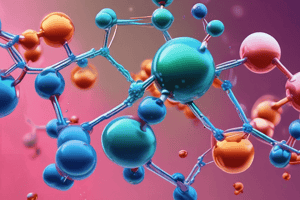Podcast
Questions and Answers
What is the main reason for the irregular variation of ionisation enthalpies?
What is the main reason for the irregular variation of ionisation enthalpies?
- Varying degree of stability of different f configuration
- Varying degree of stability of different p configuration
- Varying degree of stability of different s configuration
- Varying degree of stability of different d configuration (correct)
Which of the following is a stronger reducing agent?
Which of the following is a stronger reducing agent?
- Zn^2+
- Cr^2+ (correct)
- Fe^2+
- Cu^+
What is the electronic configuration of M^2+ ion (Z = 27)?
What is the electronic configuration of M^2+ ion (Z = 27)?
- [Ar] 3d^7 (correct)
- [Ar] 3d^5 4s^2
- [Ar] 3d^5 4s^1
- [Ar] 3d^6 4s^2
Why can oxygen or fluorine oxidise a metal to its highest oxidation state?
Why can oxygen or fluorine oxidise a metal to its highest oxidation state?
Why is Cu^+ ion not stable in aqueous solutions?
Why is Cu^+ ion not stable in aqueous solutions?
What is the reason for the actinoid contraction being greater than lanthanoid contraction?
What is the reason for the actinoid contraction being greater than lanthanoid contraction?
What is the spin-only magnetic moment of Co^2+ (Z = 27)?
What is the spin-only magnetic moment of Co^2+ (Z = 27)?
Why is the higher stability of Cu^2+ in aqueous solution attributed to?
Why is the higher stability of Cu^2+ in aqueous solution attributed to?
Why is silver considered a transition element?
Why is silver considered a transition element?
Why does zinc have the lowest enthalpy of atomisation in the 3d series?
Why does zinc have the lowest enthalpy of atomisation in the 3d series?
Which transition metal exhibits the largest number of oxidation states?
Which transition metal exhibits the largest number of oxidation states?
Why is the E° (M2+/M) value for copper positive?
Why is the E° (M2+/M) value for copper positive?
What is the reason for the irregular variation of ionisation enthalpies in the first series of transition elements?
What is the reason for the irregular variation of ionisation enthalpies in the first series of transition elements?
Which of the following transition metals does not exhibit variable oxidation states?
Which of the following transition metals does not exhibit variable oxidation states?
What is the reason for the low enthalpy of atomisation of zinc?
What is the reason for the low enthalpy of atomisation of zinc?
Which of the following is not a factor affecting the E° (M2+/M) value?
Which of the following is not a factor affecting the E° (M2+/M) value?
Flashcards are hidden until you start studying
Study Notes
Transition Elements
- Silver (Z = 47) can exhibit +2 oxidation state, which means it has incompletely filled d-orbitals (4d), making it a transition element.
- Zinc (Z = 30) has the lowest enthalpy of atomisation in the series Sc (Z = 21) to Zn (Z = 30) because no electrons from 3d-orbitals are involved in the formation of metallic bonds.
Oxidation States
- Manganese (Z = 25) exhibits the largest number of oxidation states (+2 to +7) due to the maximum number of unpaired electrons in the d-subshell.
Electrochemistry
- The E ° (M²⁺ / M) value for copper is positive (+0.34 V) because of its high enthalpy of ionisation and low enthalpy of hydration.
- The E ° (Cu²⁺ / Cu) value is related to the sum of the enthalpy change taking place in the following steps: atomisation, ionisation, and hydration.
Ionisation Enthalpies
- The irregular variation of ionisation enthalpies in the first series of transition elements is attributed to the varying degree of stability of different 3d configurations (e.g., d⁰, d³, d¹⁰ are exceptionally stable).
Highest Oxidation State
- The highest oxidation state of a metal is exhibited in its oxide or fluoride due to the small size and high electronegativity of oxygen or fluorine.
Reducing Agents
- Cr²⁺ is a stronger reducing agent than Fe²⁺ because after losing one electron, Cr²⁺ becomes Cr³⁺, which has a more stable t2g³ half-filled configuration in a medium like water.
Magnetic Moment
- The spin-only magnetic moment of Co²⁺ (Z = 27) can be calculated using the electronic configuration: [Ar] 3d⁷.
- The spin-only magnetic moment (μ) is given by the formula: μ = √(n(n + 2)) ⋅ BM.
Stability of Ions
- Cu⁺ ion is not stable in aqueous solutions because it undergoes disproportionation to form a more stable Cu²⁺ ion.
- The higher stability of Cu²⁺ in aqueous solution is attributed to its greater negative hydration enthalpy, which compensates for the second ionisation enthalpy of Cu involved in the formation of Cu²⁺ ions.
Actinoid Contraction
- Actinoid contraction is greater from element to element than lanthanoid contraction because the 5f electrons themselves provide poor shielding from element to element in the series.
Studying That Suits You
Use AI to generate personalized quizzes and flashcards to suit your learning preferences.




